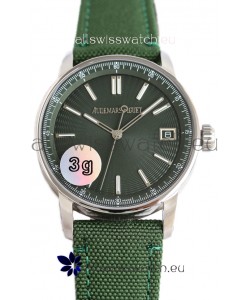Shopping Cart - 0 Item
You have no items in your shopping cart.
Audemars Piguet
Audemars Piguet is a produce that can look back on a very long company history & one that a number of other brands still involved in the laborious process of creating a firm base story could definitely be envious of. It could never dawn on anone at Audemars Piguet to name amongst their watches for the year the business started business or to write 1875 on a dial, and they doesn't create a big deal concerning the fact that in 986, for example, once the term tourbillon was relatively unknown even one of the experts, the initial serial toubillon wristwatches were already in production in Le Brassus. That the company concentrates on especially flat watches is often just mentioned in passing. Escapements made of silicon, Diamond-coated balance springs? Such things are all in a day's work for the engineers at Audemars Piguet.Going one step further, they have even developed a groundbreaking escapement according to the classic chronometer escapement using steel and ruby jewel bearings-tried and true elements that seem to have been used for watchmaking for centuries. Does Audemars Piguet reject making use of modern materials? Most certainly not, but each material is carefully selected to provide a sensible purpose, just like the cases crafted in forged carbon that make the Royal Oak Offshore a pleasantly light, but no less masculine timepiece. Forged carbon provides the benefit that every watch will likely be unique because the surface structure created during the forging process cannot be predetermined.
At the 2009 S.I.H.H. in Geneva, Audemars Piguet presented a watch ready for serial production having a balance that vibrates at the incredible frequency of 43,2000 vph, twice as fast as most manufacture movements currently being produced and quite a lot faster as opposed to 28,800 vpn industry standard.Back in 2006 the manufacture introduced a new escapement that functioned at a less frenetic 21,600 vph, but even in those days tests had shown that the AP escapements was capable of running perfectly at 43,200 vph or 6 hertz even with no lubrication of the pallet stones, which would quickly dissipate at that speed anyway. The omission of lubricant solves a problem that has plagued watchmakers for as long as mechanical timepieces have been available: gumming or hardening of the oil. This fresh escapement is based on an invention by Parisian royal clockmaker Robert Robin (1742-1799). He designed a new system in 1791 that combined the virtues of the two well-known escapements of the day, so-called free-sprung escapement and one including energy transfer via pallet fork and guard pin as part of the precursor towards the modern Swiss lever escapement as created by Thosmas Mudge in 1759.Audemars Piguet has succeeded in securing the advantages of both systems in its new high-frequency escapement, solving the oil problem and introducing a brand new and important component to the overall game: rate precision.


































































































































































































































































